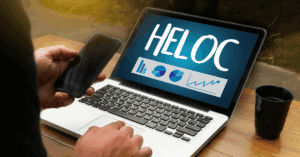Last updated: June 2025
The rising costs of energy, combined with the growing emphasis on environmental awareness, have created a substantial demand for solar energy installations.
When you add generous federal tax credits to the mix, more homeowners are asking how they can finance solar panels in a way that maximizes return and minimizes cost.
A smart solution for qualified homeowners is to use a home equity line of credit (HELOC) to finance their solar panel installation.
Pairing a HELOC with available tax incentives and long-term utility savings can provide a powerful combination of flexibility, affordability, and return on investment.
But this brings up some related questions:
- How does using a HELOC for solar panel financing work?
- What solar energy tax benefits could I qualify for?
- How can HELOCs compare with other financing options in terms of long-term ROI?
Let’s explore these and other important factors below.
Access cash within days
Tap into your home’s potential in minutes. Start our streamlined digital application to discover if a HELOC is right for you.
Why homeowners are choosing solar panels now
Key trends are driving the adoption of home solar energy:
- Rising electricity bills: Utility rates have increased significantly over the past decade, making solar power a cost-cutting solution
- Home value boost: According to one prominent survey, 71% of homeowners said their solar panels increased their home values between 6% and 15%
- Energy independence: Reducing grid reliance can give homeowners more control over their energy future
- Federal and state incentives: Programs like the Residential Clean Energy Credit (IRS) reduce upfront costs by thousands of dollars
Since solar system costs range from $15,000 to $40,000+, finding the right financing strategy is essential to maximizing those benefits.
Is HELOC the best option for solar panel financing?
HELOCs can be treated as revolving lines of credit secured by the borrower’s home. Similar to a credit card, you borrow as you need (up to your approved limit) and pay interest only on what you use.
Compared to traditional financing, a HELOC offers several distinct advantages:
- Lower interest rates: Loans are secured by borrowers’ homes—interest rates are typically much lower than credit cards or personal loans
- Flexible draw period: Borrow what you need, when you need it—ideal for solar installations with milestone-based payments
- Interest-only payments: During the draw period, monthly payments can be kept low while the solar system begins generating savings
- Fast approval and funding: HomeEQ offers a fully digital process with instant prequalification, making it easy to get started
Homeowners with strong credit and available equity can often use a HELOC as a cost-effective path to solar ownership.
How the federal solar tax credit works
The Residential Clean Energy Credit (formerly known as the Investment Tax Credit, or ITC) currently gives homeowners the ability to claim 30% of the total cost of solar panel installation as a federal tax credit. This includes:
- Equipment (panels, inverters, batteries)
- Installation labor
- Sales tax on materials
So, for a $30,000 system, you could receive a $9,000 federal tax credit, significantly reducing the net cost. The credit can be applied to the year the system is placed in service, and any unused portion can typically be rolled forward to future tax years.
Important note: This is a tax credit, not a rebate. You’ll need tax liability to benefit, and the value varies depending on your personal situation.
Consulting your preferred tax professional for personalized advice is always advisable.
ROI breakdown: Solar panels + HELOC vs other financing
Let’s consider an example scenario:
- Solar system cost: $30,000
- Federal tax credit (30%): $9,000
- Net system cost after tax credit: $21,000
- Estimated annual energy savings: $1,500
If financed through a HELOC with a 10-year repayment period and 7% interest:
- Estimated total interest paid: ~$7,800
- Total investment: ~$28,800 over 10 years
- Cumulative savings: ~$15,000 over 10 years (energy savings)
- ROI: Offset approximately 52% of total cost through savings + potential increase in home value
Now compare that with:
- Credit card at 20% APR: Much higher monthly costs and total interest (~$24,000 over 10 years)
- Unsecured personal loan at 11% APR: ~$13,000 in interest over the same term
In short, a HELOC can keep borrowing costs lower, and when paired with tax credits and energy savings, it can deliver a faster break-even point.
Hypothetical example: HELOC for solar panels in California
Elena, a homeowner in San Diego, wants to go solar to reduce her $250/month electricity bill. She’s quoted $25,000 for a high-efficiency panel system. Instead of financing through a solar lender at 10% APR, she applies for a HELOC with HomeEQ.
- Application submitted Monday
- Prequalified same day
- Funds received by Friday
She uses the HELOC to pay for the installation, claims the 30% tax credit ($7,500), and begins saving $1,500 per year in utility costs.
With interest-only payments during the draw period, she keeps her monthly out-of-pocket low while benefiting from immediate savings.
Break-even point: About 6 years, with continued savings for 15–20 years of panel life.
Does a HELOC make sense for your solar panel financing?
Financing solar panels with a home equity line of credit (HELOC) could be one of the smartest energy decisions a homeowner can make.
From tax credits to long-term energy savings and leveraging home equity, it’s a strategy that aligns financial responsibility with environmental impact.
Use our HELOC calculator to estimate your borrowing power, or apply online in minutes to see your options.




